
200 years no gospels | 24 other thrones besides Jesus' | Jesus' problematic hyperboles: made sinful lawful and lawful sinful | Jesus was created | What's new | A-Z library (3300+ articles) | "Muslims" was the original title | Quran Search | Quran Moral Code (100s of them) | Quran: Bibles are filled with corrupt قول qaowl (doctrines of sayings and writings) | "bar Allahin" in Daniel 3:25-26 means the chosen one of Allah | Jesus said he was powerless | Paul said he wasn't sure about Holy Spirit | Disciples called each other liars, satanic, false | Paul commanded women to not expose sex predators | Research & Blog | 9/11 Israel-lie | Youtube | ![]()
![]()
Where was the promised Holy Spirit in the disciples' apostatizing of each other??
The Romans had to fake his crucifixion due to Passover issues: [1]
What do bees eat according to the Glorious Quran?
The sections of this article are:
1- What does the Glorious Quran say?
2- The Scientific Proofs.
3- Conclusion.
1- What does the Glorious Quran Say?
Before we begin, I just want the reader to know that this article is not intended to demonstrate a Scientific Miracle in the Glorious Quran. The Glorious Quran has 10s (tens) of STUNNING and Overwhelming Scientific Miracles and Prophecies in It. But aside from the honey being a medicine part, I don't see in the Noble Verses below a Scientific Miracle. This article was rather written to refute the silly anti-Islamics' attacks on the Glorious Quran from the area of science, and to demonstrate their:
And to also demonstrate that the Glorious Quran is never in conflict with established science. This is a fact.
With this said, let us now look at what Allah Almighty said in the Holy Quran:
| Noble Verse(s) 16:68-16:69 |
| [016:068]
And thy Lord revealed unto the bees, saying: 'Take unto yourselves, of
the mountains, houses, and of the trees, and of what they are building. [016:069] Then eat of all manner of fruit (من كل الثمرات), and follow the ways of your Lord easy to go upon.' Then comes there forth out of their bellies a drink of diverse hues wherein is healing for men (فيه شفاء للناس). Surely in that is a sign for a people who reflect. Arabic (Read from right to left. Also, all png image files: [1] [2]. Quran Moral Code (100s of them)]): 16:68 واوحى ربك الى النحل ان اتخذي من الجبال بيوتا ومن الشجر ومما يعرشون16:69 ثم كلى من كل الثمرات فاسلكي سبل ربك ذللا يخرج من بطونها شراب مختلف الوانه فيه شفاء للناس ان في ذلك لاية لقوم يتفكرون |
The following questions are important to ask:
1- Do bees really feed off of fruits and sweet things? "all manner of fruit (من كل الثمرات)" also means all sweet-tasting things, for bees pursue all natural-sugar-tasting things, which exist heavily in fruits. Watch this bee eat from the fruit in slow motion, along with other bees eating other fruits. This video also covers the healing and medical benefits of honey, a "healing for men" (فيه شفاء للناس):
2- Do bees really feed off of nectar and fruits?
3- Do bees really live in mountains and in trees?
Also, as to honey being is a "healing for men" (فيه شفاء للناس) medicine in Noble Verse 16:69 above, please visit this article:
2- The Scientific Proofs:
The following scientific articles will answer the above questions sufficiently, insha'Allah (if Allah Almighty is Willing):
Article#1:
Children are most likely to encounter honey bees that are feeding at flowers or foraging. Bees may fly long distances (up to six miles) in search of food and may be quite far from home when they are seen in your yard or neighborhood.
Worker bees gather both pollen and nectar from flowers to feed to the larvae and other members of the colony. Nectar is the sweet fluid produced by flowers to attract bees and other insects, birds and mammals. Worker bees drink the nectar and store it in a pouch-like structure called the crop. They fly back to the hive and regurgitate the nectar to other "house bees." The house bees mix the nectar with enzymes and deposit it into a cell where it remains exposed to air for a time to allow some of the water to evaporate. The bees help the process along by fanning the open cells with their wings. The cell containing the resulting honey is later capped with beeswax and kept for future use.
Honey bees have lots of little hairs on their body. Even their eyes have hairs. Pollen sticks to the hairs while the bees are visiting the flowers. A furry little bee wiggling around inside the flower picks up a lot of pollen. After getting pollen on their body hairs, the bees move it to a special area on their hind legs called pollen baskets . Foraging bees returning to the hive often have bright yellow or greenish balls of pollen hanging from these pollen baskets.
Pollen is the yellowish or greenish powder-like substance that sometimes comes from flowers. It may be quite sticky. It contains the male contribution to the next generation of plants. Honey bees mix the pollen with some nectar to form a mixture called beebread that is a protein-rich food used to feed the larvae. As the worker bees move from flower to flower, they spread pollen to many different plants, including important foods such as vegetables (squash and cucum bers), fruits (apples, watermelon, plums, sweet cherries, citrus), nuts (almonds), plants grown for seed (sunflower), and animal feed crops such as clover.
There is evidence that Africanized honey bees spend more time collecting pollen than do European honey bees, because they need extra protein to produce more brood. One possible reason for the success of Africanized honey bees in displacing milder-tempered bees is that in every respect, the Africanized honey bees appear to be more efficient and more diligent. They get up earlier, work later, and visit more flowers per foraging flight than do European bees. When the moon is bright, Africanized honey bees will often continue to forage late into the night. This is part of the Africanized honey bee's tendency to favor expansion and frequent division of the colony, as opposed to the European honey bee's tendency to build up large, stable colonies full of honey in order to survive the winter.
Honey bees rely on their sense of vision to locate flowers. Bees see colors in the spectrum ranging from ultraviolet to orange, but do not see red, (Red flowers are visited by birds such as hummingbirds.) The flower advertises itself to the bees with colorful petals, many of which have shiny patches of ultraviolet that humans can't see except with special equipment. These ultraviolet patches are called bee guides or nectar guides. Like airport runway lights, these ultraviolet regions guide the bees to the nectar.
Shape of the flower is also important. Some flowers have flat areas for ease of landing by bees and others have elaborate modifications to ensure pollen sticks to any bee that visits.
During those hard times when there are few foraging opportunities, bees sometimes raid other, weaker colonies looking for honey to steal. The robber bees cannot enter a different hive unnoticed. Guard bees at the hive entrance usually try to fight off invaders in stinging duels. Africanized honey bees have a noticeable tendency to raid other colonies, especially during periods of drought or famine.
Honey bees are attracted to sweets, especially liquid sweets in the form of open cans of soft drinks. This is why they sometimes gather around eating areas at open air events, like fairs and carnivals, and crawl around on straws and can or bottle tops. While bees are generally not very aggressive while foraging for food or water, they can sting when disturbed, which makes them quite unwelcome at such events.
In addition to food, honey bees gather water for use in cooling the inside of the nest on hot days. They also use water to dilute the honey when they feed it to the larvae. Occasionally, honey bees collect the sticky resin and gum of trees and work into a substance called propolis. They used the propolis to plug unwanted openings in the hive so that mice and pests such as wax moths or ants can't get inside. The bees also spread a thin coating of propolis on the interior of the hive to protect against disease. When working a hive, the beekeeper uses a hive tool to pull apart the frames that may be stuck together with propolis." (Source)
As we clearly see here:
1- Bees feed off of nectar and pollen.
2- Bees do feed off of sweets, which obviously includes all fruits. "all manner of fruit (من كل الثمرات)" also means all sweet-tasting things, for bees pursue all natural-sugar-tasting things, which exist heavily in fruits. Watch this bee eat from the fruit in slow motion, along with other bees eating other fruits. This video also covers the healing and medical benefits of honey, a "healing for men" (فيه شفاء للناس):
3- Pollen is the male part of the next-generation of plants. Also, "all manner of fruit (من كل الثمرات)" does include pollen. While the scientific terms of today do not exist in the Glorious Quran, but the references to them are still there.
Article #2:
Honey bees collect nectar from fruit flowers:
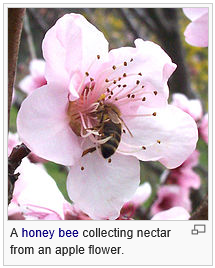
"The nectar sources from large cultivated fields of blooming apples, cherries, canola, melons, sun flowers, clover etc. are of benefit to a bee keeper who is willing to travel with his hives throughout the season." (Source)
"Sugar concentration plays a greater role in bee attraction than the proportions of the various sugars in the nectar. Weather conditions aside, different plants naturally produce nectar in different quantities and concentrations. For example, apple nectar is more attractive to bees than pear nectar because it has a higher sugar concentration. Different plants compete for bee visits and to obtain maximum bee visitation to fruit flowers, competing flora (for example, weeds) should be controlled whenever possible." (Source)
The Glorious Quran's "all manner of fruit (من كل الثمرات)" does include the fruit nectar.
Article #3:
More on Pollen and Fruit Propagation:
Worldwide, honeybees (Apis mellifera) have
been the most economical and reliable option for pollinating most crops and
the most important pollinator
for apples in North America." (Source)
From
http://users.rcn.com/jkimball.ma.ultranet/BiologyPages/A/Angiosperm.html:
Sexual Reproduction in AngiospermsAngiosperms are the flowering plants (today the most abundant and diverse plants on earth). Most are terrestrial and all lack locomotion. This poses several problems.
The functions of the flower
solve both of these problems. The Flower and Its PollinationIn angiosperms, meiosis in the sporophyte generation produces two kinds of spores.
Both types of sporangia are formed in flowers. In most angiosperms, the flowers are perfect: each has both microsporangia and megasporangia. Some angiosperms are imperfect, having either microsporangia or megasporangia but not both.
 Flowers develop from flower buds. Each bud contains 4 concentric whorls of tissue. From the outer to the inner, these develop into
StamensEach stamen consists of a
Meiosis of the diploid microspore mother cells in the anther produces four haploid microspores. Each of these develops into a pollen grain consisting of
CarpelsCarpels consist of a
Often the entire whorl of carpels is fused into a single pistil. The megasporangia, called ovules, develop within the ovary. Meiosis of the megaspore mother cell in each ovule produces 4 haploid cells:
Development of the megaspore
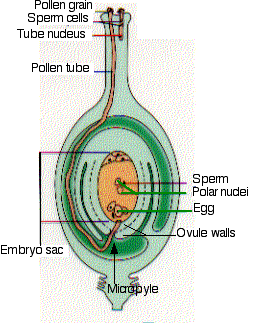 The nucleus of the megaspore undergoes 3 successive mitotic divisions. The 8 nuclei that result are distributed and partitioned off by cell walls to form the embryo sac. This is the mature female gametophyte generation.
PollinationWhen a pollen grain reaches the stigma, it germinates into a pollen tube. If it hasn't done so already, the germ cell divides by mitosis forming 2 sperm cells. These, along with the tube nucleus, migrate down the pollen tube as it grows through the style, the micropyle, and into the ovule chamber. In Arabidopsis the pollen tube follows a gradient of increasing concentration of gamma amino butyric acid (GABA; the same molecule that serves as an important neurotransmitter in the human brain Link). Two other chemicals that have been found in other species to guide pollen tubes to their destination are
The pollen tube with its contents makes up the mature male gametophyte generation. Double fertilizationThe pollen tube enters the ovule through the micropyle and ruptures.
Self-incompatibilityMost angiosperms have mechanisms by which they avoid self-fertilization. Link to a discussion of these.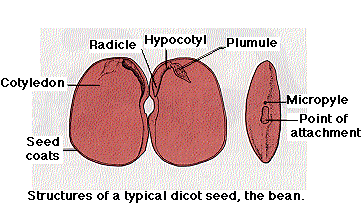 SeedsAfter double fertilization, each ovule develops into a seed, which consists of
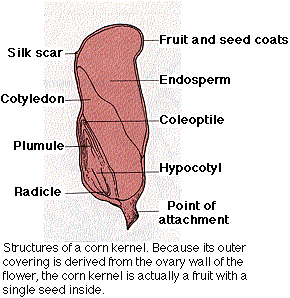 The food in the cotyledons is derived from the endosperm which, in turn, received it from the parent sporophyte. In many angiosperms (e.g., beans), when the seeds are mature, the endosperm has been totally consumed and its food transferred to the cotyledons. In others (some dicots and all monocots), the endosperm persists in the mature seed. The seed is thus a dormant embryo sporophyte with stored food and protective coats. Its two functions are
Fruits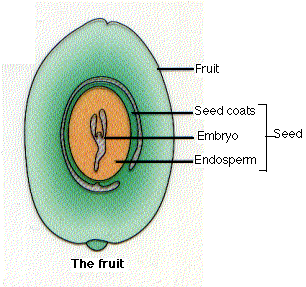 Fruits are a development of the ovary wall and sometimes other flower parts as well. As seeds mature, they release the hormone auxin, which stimulates the wall of the ovary to develop into the fruit. In fact, commercial fruit growers may stimulate fruit development in unpollinated flowers by applying synthetic auxin to the flower. Fruits promote the dispersal of their content of seeds in a variety of ways.
|
And again, "all
manner of fruit (من
كل الثمرات)"
does include pollen. While the scientific terms of today do not exist in
the Glorious Quran, but the references to them are still there.
Article #4:
"Do bees go after human food like flies do?
Honey
bees are attracted to sugar. They
really come after sweet stuff during a drought or the very hottest day of summer
when flowers are scarce. Dr. Pepper is a favorite. I know more than one guy at
work stung on the lip because a bee went into his soda can. If you leave your
windows down sometimes bees will get all inside after soda cans or spilt soda.
I have put out thick sugar water for bees
before in summer and bee keepers often feed bees.
Surely most of you have read of tracking bees to the hive. In elementary school
we read about it. They put syrup in a small box and the bees begin to arrive.
They powdered one's behind with flour and timed how long it took him to return
from a trip to the hive for more syrup. With this they calculated distance to
hive and followed the flight path to the bee tree." (Source)
Article #5:
"Junk-food honey bees
Someone forwarded a link to this New York Times story yesterday, and it got me thinking about the junk that honey bees eat. Every fall, people report problems with honey bees being attracted to trash cans, soda cans, and all variety of sweet things. I've always believed this phenomenon was due to the combined effect of a declining natural supply of nectar and possibly an enhanced craving for carbohydrates prior to winter (stoking the fires for a long, cold winter)." (Source)
Article #6:
The following was an addition from brother Dawud on this this website's blog; may Allah Almighty always be pleased with him:
"Honey bees typically search for flowers containing nectar and pollen for food. However, they are very opportunistic, and will seek syrups, sugar, fruit juices, and other sweet substances within easy access when flowers are not available." (Source)
Again, the Glorious Quran's "all manner of fruit (من كل الثمرات)" does include the fruit nectar as well as all fruits that bees feed off of.
Article #7:
"When bees decide to move to a new home and begin a new colony, "scouts" head out to find a location. These bees are able to travel many miles form the original hive but still find the way back to the colony. Wild bees usually prefer rock crevices, hollow trees and other small, enclosed areas for hives. Once the scouts have found a suitable location, they return to the colony and lead the other bees there. The bees, including the queen, fill their stomachs with honey for the long journey to the site of the new nest. Food that is not digested is regurgitated and used as building materials for the new hive." (Source)
"Bee Facts:
Bees can flap their wings as fast as 11,000 times per second.
They flap their wings to do a lot of things, but one reason is to heat and cool
the hive at all times. The worker bees keep the hive at a steady temperature all
year round with their wing flaps. They would like it to be 92-93 degrees --
which is pretty warm.
Honey bees fly in a radius of about 3-5 miles from their homes to
forage for flowers and food."
(Source)
As we clearly see here from all of the above articles:
1- Bees build their hives in trees and in rocks, and anywhere on land that they may feel safest in.
2- Bees travel for miles to search for flower's nectar and also for food.
3- Conclusion:
The Glorious Quran is in perfect harmony with the established science about the bees. Also honey, as I linked above, was proven to be a healing medicine by science today, and Allah Almighty mentioned this fact about honey 1,400 years ago, a "healing for men" (فيه شفاء للناس). Again, here are some of honey's medical benefits:
1- It's a natural remedy.
2- It's an antibiotic. It is call Apitherapy Raw Honey, which includes replenishing energy, enhancing physical stamina, and improving the immune system.
3- It has anti-microbial properties. It forms a hydrogen peroxide effect in wounds and destroys bacteria.
4- In the wound, honey also allows for skin cells to re-grow naturally, and it prevents raised scarring.
5- Honey has Acidic PH which is inhospitable for bacteria.
6- It also has an Asmonic effect, which draws out fluid from the bacteria.
7- Honey also heals burn injuries.
Please visit: Honey was proven to be a healing medicine for humans as was mentioned in the Noble Quran.
Indeed, all Praise and Glory are due to Allah Almighty alone for making the Noble Quran be the Perfect and Everlasting Miracle, for us humans, out of all of His Divine Miracles! And may Allah Almighty send His Peace, Mercy and Blessings upon our Beloved and Blessed Prophet, Teacher and Role Model, Muhammad. Ameen.
The Overwhelming Scientific Miracles in the Glorious Quran.
The amazing Prophecies of the Glorious Quran and Islam.
Honey was proven to be a healing medicine for humans as was mentioned in the Noble Quran.
Islam and the Noble Quran - Questions and Answers.
Dhul Qarnayn's story. Sunrise and sunset. Also Why حمئة and not حاميةٍ. Dhil Qarnayn's journey is detailed with scientific and geographical maps that are more 1000 years old.
|
Allah Almighty
in the Glorious Quran said that earth is:
- Spherical: "egg-shaped" [1].
-
The Glorious Quran also speaks about
many earths
[5]
and not just earth.
In the end, Allah Almighty uses the Glorious Quran to "...Thus doth God leave to stray whom He pleaseth, and guide whom He pleaseth..." (74:31). The infidels misuse the Glorious Quran to find "scientific errors". The Glorious Quran is Allah Almighty's Perfect Divine Holy Book. It contains no scientific error. Visit the following example and the link to see 1000s of Numerical and Scientific Miracles: 1- The root for message and all of its derivatives, such as messenger and others occurs 513 times throughout the Glorious Quran. The Prophets' and Messengers', peace be upon them, actual names (Muhammad, Moses, Noah, Abraham, Lot etc....) were also all combined mentioned 513 times in the Glorious Quran. The detailed breakdown of all of this is thoroughly listed here. Coincidence? See 1,000s of examples! [1]. (zip file). Quran's Stunning Numerical & Scientific Miracles. Stunning Prophecies [2] [3] |
|
Quran's
STUNNING
Divine Miracles:
[1] Here are some of my favorite Stunning Numerical and Scientific Miracles in the Glorious Quran that are listed in the main sections, below: 1- The root for message and all of its derivatives, such as messenger and others occurs 513 times throughout the Glorious Quran. The Prophets' and Messengers', peace be upon them, actual names (Muhammad, Moses, Noah, Abraham, Lot etc....) were also all combined mentioned 513 times in the Glorious Quran. The detailed breakdown of all of this is thoroughly listed here. Coincidence? See 1,000s of examples! [1]. (zip file). Quran's Stunning Numerical & Scientific Miracles. Stunning Prophecies [2] [3] 2- The Great Miracle. Allah Almighty in the Holy Quran called the Number 19 Miracle "One of the Mighty Ones (Miracles)" (74:30-37) [1] [2]. See the 100s of Noble Verses that clearly testify to this Great Miracle. Also, did you know that Allah Almighty Said in Surat Nuh (that's Noble Chapter Nuh (Noah)) that Prophet Noah lived for 950 years among his people. Yet, all Praise and Glory are due to Allah Almighty Alone, the entire Noble Surah is exactly written in 950 Letters [1] [2]! You can thoroughly see this in the scanned images that thoroughly verify every single Noble Letter, in the links. Click on the links to see the many other Numerical Miracles in the Holy Quran. Also, see the Numerical Miracles section along with all of the other great sections. Also, 1,000s of examples in zip & PDF (fonts) files all demonstrated in this article.
4- The Glorious Quran has 114 Chapters. The sum of those Chapters is 6555 (1+2+...+114 = 6555). There are also 6236 Noble Verses in the Glorious Quran. Now, if you add each Chapter's number with the number of its Verses, then you get a list of numbers. So 1 (first Chapter) + 7 (# of its Verses) = 8. Do this for all Chapters.
1-
The sum of the odd numbers from the list =
6555. See the XLS file for 100% confirmation. Also, see the ample STUNNING Numerical Miracles in the Glorious Quran, with 1,000s of examples! [1] (zip file).. See also the ample Textual Miracles [2] in the Glorious Quran, where Noble Words are spelled in certain ways depending on their certain historical and geographical context and timing in the Noble Verse.
5- Please also checkout the many hundreds (1,000s) of Great Numerical Miracles, and the many tens (10s) of other Great Scientific Miracles:
1- The explosion
of the Universe,
Galaxies and
Stars bring about
Smoke. As we also see from the picture, Noble Verse 55:37
The
Glorious Quran
declares that the
earth is
spherical:
[1]
www.answering-christianity.com/egg-shaped_earth.htm
6- The Glorious Quran's Perfect Preservation despite all of the odds and the many challenges to corrupt It.
7- Prophet Muhammad, and Divine Islam, and the New Covenant from Arabia were thoroughly prophesied in previous scriptures. |
Where was the promised Holy Spirit in the disciples' apostatizing of each other??
The Romans had to fake his crucifixion due to Passover issues: [1]
200 years no gospels | 24 other thrones besides Jesus' | Jesus' problematic hyperboles: made sinful lawful and lawful sinful | Jesus was created | What's new | A-Z library (3300+ articles) | "Muslims" was the original title | Quran Search | Quran Moral Code (100s of them) | Quran: Bibles are filled with corrupt قول qaowl (doctrines of sayings and writings) | "bar Allahin" in Daniel 3:25-26 means the chosen one of Allah | Jesus said he was powerless | Paul said he wasn't sure about Holy Spirit | Disciples called each other liars, satanic, false | Paul commanded women to not expose sex predators | Research & Blog | 9/11 Israel-lie | Youtube
Quran's STUNNING Divine Miracles: [1] Allah Almighty also promised in several Divine Prophecies that He will show the Glorious Quran's Miracles to mankind. For example:
Coincidence? See 1,000s of examples [1].Quran's Stunning Numerical & Scientific Miracles.
"I cannot do anything on my own." (i.e., Jesus could not perform a single Miracle without GOD sending it down to him first!). I can not perform a single Miracle on my own!! I am totally POWERLESS without Allah Almighty! John 5:31 "if I (Jesus) bear witness of myself, then I would be a liar!" GOD didn't talk this way when He spoke to Moses. GOD's testimony alone is always sufficient! Jesus also bowed his face down to the ground, like we Muslims (Isaiah 56:5: Muslim is the future believers' name, and sons and daughters of GOD titles will be "no more"; |